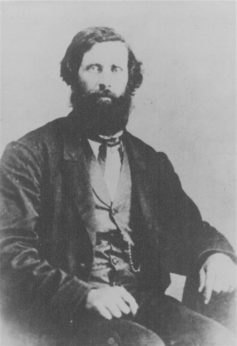The story behind "Home on the Range," the most American of songs.

But even as it was being penned by a frontier doctor living in remote north-central Kansas, the sound of the mighty herds of bison, known as the “thunder of the plains” for the earth-shaking rumble they created as they galloped across the grasslands, was already beginning to fade.
Dr. Brewster Higley VI wrote a six-verse poem titled “My Western Home” in 1871 while living in a dirt-floor cabin near Smith County, Kansas’s West Beaver Creek. He’d left his children in Illinois and fled to Kansas following the end of his fourth marriage to Mercy Ann McPherson, a widow with a wicked temper. When not practicing his profession (Higley was an otolaryngologist, which is essentially an ear, nose, and throat doctor) he would wile away the time playing the violin or writing poetry.

Brewster Higley VI, author of “Home on the Range.” Wikimedia Commons
Shortly after penning “My Western Home,” a paean to the the natural beauty of his small patch of Kansas land, Higley tucked it away in a book and promptly forgot about it. The poem wasn’t rediscovered until a few years later, in 1873, when Trube Reese brought his doctor friend some business – a gunshot victim in need of patching up. As Reese perused the doctor’s library, a piece of paper fluttered out of the book he was handling. He picked it up and read the poem. “This is plum good. You should have it printed in the paper,” Reese is purported to have told the doctor.
Higley took his friend’s advice and soon the poem was printed in a few local newspapers. But perhaps the smartest thing the doctor ever did was to ask his friend Daniel Kelley – who had been a bugler during the Civil War – to put his words to music. The song took off like a prairie wildfire, securing it’s place in the American songbook after cowboys and others spread the tune far and wide. Higley never did see any money from the song, though, since he never bothered to copyright it.
“Home on the Range,” it turned out, was an epitaph of sorts for the wild Kansas Higley had loved. America’s bison herds were estimated at 30 to 60 million strong in the mid-19th century, but less than 50 or so years later, there were only 300 bison left in the wild. Nearly all of the various Native American tribes from Kansas had either been killed off or forced onto reservations.
It was the Kansas Pacific Railroad, completed in the early 1870s, that helped lead to the decimation of the massive bison herds. It made travel from the East easier for the thousands of hunters who came to shoot the animals, some for sport, some for profit. (The federal government paid hunters $80 a day, the equivalent of $1,400 now.) The wholesale slaughter of the herds was directly related to the U.S. government’s aim of assimilating the Native American population. Gen. Philip Henry Sheridan, who headed up the Indian Wars, lauded the extermination of the bison as a means to “settle the vexed Indian question” since the Plains tribes relied heavily on the bison for food and other supplies.

An ilustration of hunters shooting bison from a train of the Kansas Pacific Railroad. Image from the 1889 book “The Extermination of the American Bison” by William T. Hornaday via The Gutenberg Project
By 1886, Higley was through with Kansas. He headed south to Van Buren, Arkansas, with wife number five – he had married yet again a short time after wife number four had obtained a divorce – and his four children (by wife number five). He retired from practicing medicine and instead focused on farming and growing fruit. He died in 1911, in Shawnee, Oklahoma.